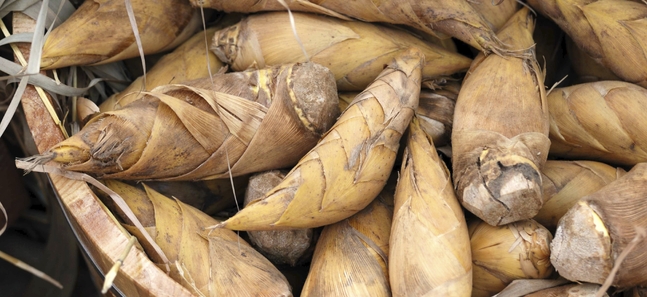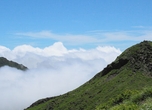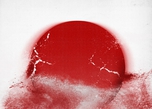66 things to do this spring: 21-30
From beer festivals to botany, there's still plenty to see and do in Tokyo

Posted: Fri Apr 01 2011
21. Chomp on some bamboo shoots
If you aren't already scoffing down slices of takenoko – bamboo shoots – as you read this, then your time is running out. There's a slim window of opportunity during the lifespan of a bamboo plant where its shoots can be eaten, making it perhaps the quintessential Japanese spring vegetable. Eat it raw, as tempura, or with rice to make the popular comfort food, takenoko gohan. Takenoko season usual runs until late April
22. Go globetrotting without leaving town
There are free parties going on in Yoyogi Park most weekends – and no, we don't mean the kind that get shut down by the police within half an hour. An open-air stage area close to the iconic Yoyogi National Stadium hosts a wide range of themed events throughout the year, from eco markets to celebrations of marginalised south-east Asian countries. Two of the liveliest take place on consecutive weekends: the Thai Festival on May 14-15, followed by the One Love Jamaica Festival on May 21-22. Both promise live music, dancing, and a heap of stalls selling handicrafts, food and drink from the respective countries. Transport: Harajuku Station (Yamanote, Chiyoda lines)
23. Celebrate under cover of darkness
Okunitama Shrine in Fuchu ranks among the oldest shrines in the Tokyo area, but it's got another claim to fame too: it's home to one of the regions 'three bizarre festivals'. The Kurayami Matsuri – literally, 'Darkness Festival' – earned its name thanks to the Edo-era practice of holding the main parade after the city's lights had been turned out. These days, you needn't worry about missing your last train home: the parade leaves the shrine at the more reasonable hour of 6pm on May 5. April 30-May 6. Transport: Fuchu-Hommachi Station (Musashino, Nambu lines) or Fuchu Station (Keio line)
24. Head back in time
Tokyo’s facade may be in a never-ending cycle of renewal, but its architectural heritage is well preserved in an unexpectedly rich hoard of buildings at this picturesque branch of the Edo-Tokyo Museum. As well as swanky private residences and quaint old town shops, there’s a host of one-offs, such as an ornate bathhouse and a mausoleum built for a shogun’s wife. Even the visitors’ centre once served as a ceremonial pavilion in front of the Imperial Palace. Be prepared for lots of slipping in and out of shoes if you want to visit the interiors. Open Tuesdays-Sundays, 9.30am-4.30pm. Adults 400 yen, kids 200 yen. 3-7-1 Sakuracho, Koganei Ishi, Tokyo (042 388 3300). Transport: Musashi-Koganei Station (Chuo line)
25. Pet a farmyard critter
This is mainly for the children, though obviously there are no hard and fast rules. If petting fowl and livestock seems like the kind of thing that’d make you happy, head on over to the petting area, a leafy enclosure at Ueno Zoo. It’s basically a huge love-in for the kids, though we can’t imagine it being much fun for the chickens – poor things can’t walk two metres without having their feathers ruffled. Ueno Zoo, Tuesdays-Sundays, 9.30am-5.00pm. Adults, 600 yen, kids, 200 yen. 9-83 Ueno Koen, Taito-ku, Tokyo (03 3828 5171). Transport: Ueno Station (Yamanote, Keihin-Tohoku, Ginza, Hibiya lines)
26. Fill up on pink
Hanami parties may have been all but banned this year, but that doesn’t mean you can’t get out and appreciate the flowers for being something other than a canopy for your beery noisiness. The flowers turn the city pink for the first weeks in April – if you want to see them somewhere special, check out our Tokyo sakura guide.
27. Get into hot water
There’s nothing on earth like bathing in a Japanese hot spring, and there are a decent number in and around the capital for you to make the most of. Get outside and get naked today! You’ll find all you need in our Tokyo onsen guide.
28. Relive your youth, catch a cheesy rock act
Ah, Mr. Big. What would our hairy teenage years have been without you? More importantly, what would the Japanese music scene have looked like had you not arrived twenty years ago looking like all of Glay's wet dreams come at once? That Japan was a key part of last year's reunion celebrations shows just how much Paul Gilbert and the boys mean to this country, and they return, no doubt feeling justifiably triumphant, to Tokyo Budokan towards the end of April, bringing their latest album What If... along for anyone who cares. Personally, and we feel we speak for the majority of ticket holders here, if it's not, 'To Be With You', we're not listening. Mr Big, April 25, 6pm. Tickets, 8,000-9,000 yen. Budokan, 2-3 Kitanomaru-koen, Chiyoda-ku, Tokyo. Transport: Kudanshita Station (Hanzomon, Shinjuku, Tozai lines)
29. Send books and toys to the children of Tohoku
The organisers of Beers for Books are encouraging Tokyo residents to come together and donate new books, toys and games to the children affected by the disaster in the north at this April 10 charity event. Any items collected with be distributed by Kokkyo Naki Kodomotachi. Keeping with the usual Beers for Books manifesto, 100 yen of every 500 yen drink you buy during the event will also go to the relief effort. A raffle is also planned – the 1,000 yen you are encouraged to donate on the door will get you three tickets. Beers for Books, 6pm-10pm, April 10. Opera Lounge, 5F Izumi Garden, 1-6-1 Roppongi, Minato-ku (03 5575 8055). Transport: Roppongi Itchome Station (Namboku line)
30. Celebrate nature
Late spring, just before the rainy month begins, it's hotaru season – a brief period of days, drenched in sweat and nostalgia, when Genji fireflies come out and enchant riverbanks across the country. The festivals that surround their appearance are often friendly affairs, none more so than the annual Fussa Hotaru Matsuri, which turns 45 on June 12, 2011. Locals are known to breed the fireflies and release them in Fussa Hotaru Park, and it is thought that best time to see the flies is between 8pm and 9pm. It's likely to be a crowded event, so visitors are advised to come via public transport. Transport: Ushihama Station (Ome line)
Tweets
- About Us |
- Work for Time Out |
- Send us info |
- Advertising |
- Mobile edition |
- Terms & Conditions |
- Privacy policy |
- Contact Us
Copyright © 2014 Time Out Tokyo














Add your comment